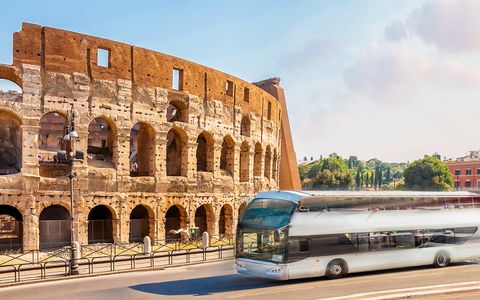Getting Around Rome: A Tourist’s Guide to Transportation and Travel Logistics
 Zachary Fincham
16 Jul, 2025
7 mins read
73
Zachary Fincham
16 Jul, 2025
7 mins read
73

Rome, the Eternal City, captivates millions of visitors each year with its breathtaking history, world-renowned cuisine, and iconic landmarks such as the Colosseum, Vatican City, and Trevi Fountain. But while the sights and experiences are unforgettable, navigating Rome efficiently can make or break your trip. Understanding the city’s transportation options and key travel logistics is essential for a smooth, enjoyable experience. This guide offers tourists practical information on how to get around Rome, including airport access, port transportation, and local transit solutions.
Arriving in Rome: Airport Information
Rome is served by two major airports: Leonardo da Vinci–Fiumicino Airport (FCO) and Ciampino–G.B. Pastine International Airport (CIA). Fiumicino is the primary international gateway, located about 30 kilometers (18 miles) southwest of the city center, and handles most long-haul and international flights. Ciampino, located around 15 kilometers (9 miles) southeast of Rome, is smaller and mainly services budget airlines and European destinations.
Travelers arriving at either airport have several options to reach the city center: trains, buses, taxis, and private transfers. The Leonardo Express is a popular non-stop train from Fiumicino to Roma Termini (central station), running every 15–30 minutes. Taxis are available outside both airports, with fixed fares into central Rome. For a more personalized, stress-free arrival, many visitors opt for pre-booked Rome airport transfers, which offer comfort, reliability, and assistance with luggage — especially beneficial after a long flight.
From Port to Capital: Reaching Rome from Civitavecchia
If you're arriving in Rome via a Mediterranean cruise, you'll likely dock at the Port of Civitavecchia, the main cruise and ferry terminal serving the city. Situated about 80 kilometers (50 miles) northwest of Rome, the port connects travelers from across Europe and beyond. While regional trains do connect Civitavecchia to Rome’s Termini station, they may not always be convenient for cruise passengers with tight schedules or heavy luggage.
To ensure a hassle-free journey from ship to city, many cruise-goers choose organized shuttles or private car services. Pre-arranged transportation such as Civitavecchia port to Rome transfers offer door-to-door service, timely pickups, and a smooth ride directly to your accommodation or tour start point.
Navigating Rome’s Public Transportation
Once in the city, getting around Rome is straightforward thanks to its extensive public transport network, which includes metro lines, buses, trams, and suburban trains. The ATAC public transportation system operates most services, and tickets can be purchased at newsstands, metro stations, and convenience shops. One ticket covers multiple modes of transport and is valid for 100 minutes from first validation.
Rome's Metro system has three main lines (A, B, and C) and is often the quickest way to traverse long distances. However, the metro network is limited compared to other major cities. Buses and trams help fill in the gaps, offering more localized routes to key attractions. For sightseeing, the Roma Pass or Omnia Vatican and Rome Card provides unlimited access to public transport along with entry to several museums and monuments.
Taxis and Rideshare
Taxis in Rome are white with a taxi sign on the roof and a meter inside. Always use official taxis to avoid scams. Rome also supports ride-hailing apps such as Free Now and Uber, although Uber operates under a more premium model compared to its standard low-cost services elsewhere.
Walking and Biking
Rome is a walkable city, especially in its historic center, where many attractions are located close together. Strolling through cobblestone streets is part of the charm, but wear comfortable shoes — Rome’s terrain includes hills and uneven surfaces. For eco-friendly travelers, bike rentals and e-scooters are also available throughout the city, with several mobile apps offering on-demand service.
Final Travel Tips
- Plan ahead during peak season (spring to early fall), when public transport and tourist hotspots can get crowded.
- Avoid driving in central Rome unless necessary — traffic is dense and parking is scarce.
- Validate your tickets before boarding buses or trams to avoid fines.
- Keep valuables secure in crowded areas and on public transport.
Conclusion

With its rich history and vibrant culture, Rome offers an unforgettable travel experience — and understanding your transportation options ensures you can make the most of every moment. Whether you're landing at the airport, disembarking from a cruise, or navigating the city streets, a bit of planning and the right travel choices can turn your Roman holiday into a seamless adventure. From convenient Rome airport transfers to reliable services from the Civitavecchia port to Rome, a well-prepared arrival and commute make all the difference. Buon viaggio!
Written By:
Zachary Fincham



Hotels at your convenience
Now choose your stay according to your preference. From finding a place for your dream destination or a mere weekend getaway to business accommodations or brief stay, we have got you covered. Explore hotels as per your mood.





